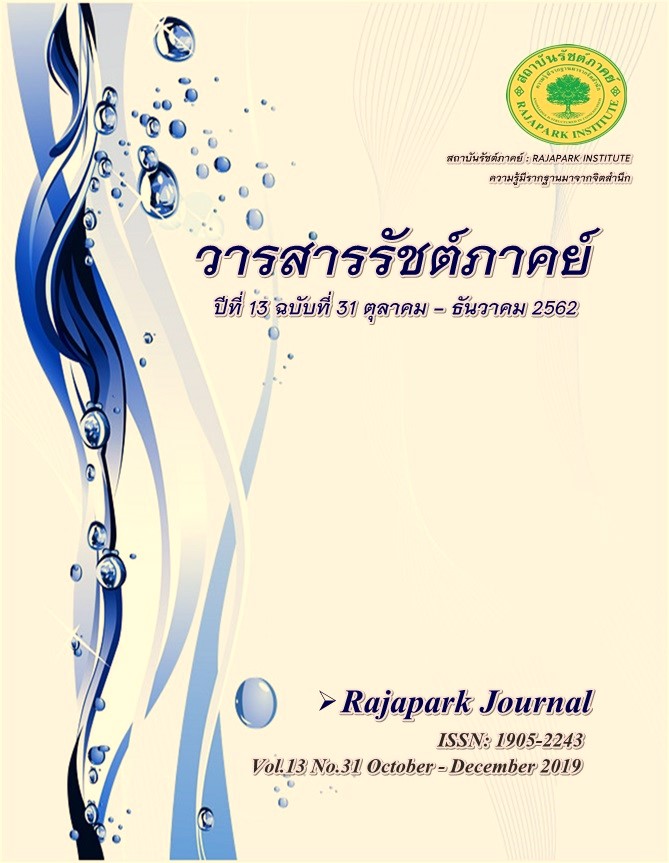Effects of Using Graphic Organizers Technique to Enhance Undergraduate Students’ English Critical Reading Skills
Main Article Content
Abstract
The objectives of this research were to 1) compare students’ English critical reading skills before and after using graphic organizers technique and 2) survey the students’ satisfaction toward the graphic organizers technique. Sample was selected by a simple random sampling technique, comprised 36 undergraduate students, faculty of Engineering and Industrial Technology, Silpakorn University. Research instruments included 1) learning units with graphic organizers technique to enhance undergraduate students’ English critical reading; 2) an English critical reading achievement test and 3) the satisfaction questionnaire toward the graphic organizers technique. Statistics for data analysis were mean and standard deviation, and t-test on independent variables. The results revealed that 1) the students’ English critical reading skills after using the graphic organizers were significantly higher at the .05 level, and 2) the students’ satisfaction toward the graphic organizers technique was at the very satisfied level.
Article Details

This work is licensed under a Creative Commons Attribution-NonCommercial-NoDerivatives 4.0 International License.
Views and opinions appearing in the Journal it is the responsibility of the author of the article, and does not constitute the view and responsibility of the editorial team.
References
Ausubel, D. P. (1968). Educational psychology: A cognitive view. New York: Holt, Rinehart and Winston.
Barchers, S. I. (1998). Teaching Reading: From Process to Practice. London: Wadsworth.
Barrett, F. C. (1932). Remembering. New York: Cambridge University Press.
Boonplong, C. (1998). The development of a model for a computer-assisted instruction lesson for teaching critical reading for lower secondary school students. Doctor of Education Thesis, Chulalongkorn University.
Bromley, K., Irwin-De Vitis, L., & Modlo, M. (1995). Graphic Organizer. New York: Scholastic.
Cooper, J. et al. (1988). The What and How of Reading Instruction. (2nd ed.). Ohio: Merrill.
Davine, T. G. (1987). Teaching studying skills: A guide for teachers. (2nd ed.). Boston: Allyn and Bacon.
George D. Spache., & Evelyn B. Spache. (1969). Reading in the Elementary School. (2nd ed.). Boston: Allyn and Bacon, Inc.
Grabe, W. (2009). Reading a Second Language: Moving from Theory to Practice. New York: Cambridge University Press.
Griffiths, D. (1995). Evaluating Materials for Teaching English to Adult Speakers of Other Languages. English Teaching Forum, 33(3), 50-51.
Joyce, B., & Weil, M. (1992). Model of Teaching. (5th ed.). Boston: Allyn and Bacon.
Maas, V. (2007). Using Pre-Reading Learning Strategies to Better Prepare ELLs for Texts in Guided Reading. [Online]. Retrieved June 21, 2017, from https://digitalcommons.hamline.edu/hse_all/352/.
Masoot, W. (2013). The development of reading exercises by using think-aloud and the graphic organizer technique for developing English reading comprehension ability and reading strategies for the first-year students, Faculty of Education, Silpakorn University. Master of Education Program in Teaching English as a Foreign Language, Graduate School, Silpakorn University.
McKee, P. (1966). Reading a Program of Instruction for the Elementary School. Boston: Houghton Mifflin.
Miller, Wilma H. (1990). Reading Comprehension Activities Kit: Ready-to-Use Techniques and Worksheets for Assessment and Instruction. Center for Applied Research in Education.
Novak, J. D. & Gowin, D. B. (1984). Learning how to learn. New York: Cambridge University Press.
Nunan, D. (1999). Second language teaching and learning. New York: Heinle & Heinle.
Nunan, D. (2004). Task-Based Language Teaching. Cambridge: Cambridge University Press.
Panich, W. (2001). Graphic Organizers and Advantages in Teaching. Bangkok: Chulalongkorn University.
Ruddell, R. B. (2002). Teaching Children to Read and Write: Becoming an Effective Literacy Teacher. Allyn and Bacon: Boston.
Samanpan, T. (2006). The Effect of Using an Instruction Model Emphasizing Critical Thinking Processes and Flexible Learning on Developing Critical Reading Ability in English. Doctor of Philosophy Program in Curriculum and Instruction, Graduate School, Khon Kaen University.
Seels, B., & Glasgow, Zita. (1990.) Exercise in Instructional Design, Ohio: Merill Publishing Company.
Sudjaicheun, K., & Torut, S. (2017). Effects of An English Supplementary Reading Material Focusing on Vocabulary Learning and Text Structure Analysis on Vocabulary Learning and Reading Comprehension of Mattayomsuksa Four students of Banglane Wittaya School, Amphur Banglane, Nakhon Pathom. Master of Education Program in teaching English as a foreign language, Graduate School, Khon Kaen University.
Tantisattayanon, Y. (2012). Development of business English reading modules focusing on business ethical issues to enhance critical reading skills and business ethical awareness for the students of Rajamangala University of Technology Rattanakosin. Doctor of Philosophy Program in Curriculum and Instruction, Graduate School, Silpakorn University.
Thai Qualification Framework. (2560). Faculty of Engineering and Industrial Technology. Retrieved June 21, 2017, from https://www.eng.su.ac.th/upload/course.pdf.
Vygotsky, L. S. (1962). Thought and language. Cambridge, MA: MIT Press.
Wallance, C. (2003). Critical Reading in Language Education. New York: Palgrave Macmillan.
Williams, E. (1986). Reading in the Language Classroom. London: Macmillan Publishers.


